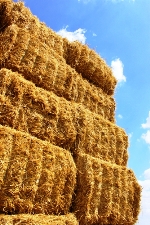This story from FOX 47 News in Lansing, Michigan on September 20:
“Strong winds spread a fire from a burning trash pit to a pole barn in Stockbridge Township Wednesday evening.
The Stockbridge Deputy Fire Chief tells us the pit was about 40 feet from the barn. The owner called 911 around 5:45pm when he saw smoke. There were several horses in the barn, all of which escaped.
Some farm equipment stored inside may have been damaged.
Firefighters had to use a backhoe to remove burning hay from the barn before they could put the fire out. Nobody was injured and the fire did not spread to the surrounding corn fields.”
In my humble opinion, the burning of this pole barn had absolutely nothing to do with the pole barn itself, but everything to do with the “Triple Whammy” put on it by the building’s owner.
Whammy number one….having a trash pit for burning within 40 feet from a building to begin with.
Whammy number two….burning in aforementioned trash pit when strong winds were present.
 And…the envelope please….Whammy number three….hay storage inside of a barn with animals and farm equipment.
And…the envelope please….Whammy number three….hay storage inside of a barn with animals and farm equipment.
Without the first two whammies, the hay storage alone is an issue. In the above story, winds drove flames into the hay stored within the pole barn. However a bigger risk lies in those stacks of hay. Lives have been lost and hay crops destroyed because of fires caused by spontaneous combustion. Any time you have hay storage with above 20-25% moisture content, spontaneous combustion may occur.
Hay which is stored when too wet will heat rapidly. If heat loss is restricted, the internal temperature of the bales will rise. As the temperature rises above 130°F, a chemical reaction occurs and may sustain itself. This reaction does not require oxygen, but the flammable gases produced are at a temperature above their ignition point. These gases will ignite when they come in contact with the air.
Besides the obvious (don’t store overly wet hay), it is also prudent to not store hay in the same building with animals and equipment. The premiums paid for fire insurance can be potentially reduced by minimizing the risks.






